Want healthy onions? Plant them in the right place, at the right time, in the right soil! Growing onions isn’t very hard, but like all of us, they have preferences that will help them thrive in your garden at home.
Every choice you make when growing onions, from where you plant them, to the soil composition, makes a huge difference. These onion-growing tips below are practically guaranteed to make sure you grow an onion crop big enough for all the French Onion Soup, Caramelized Onions, and Onion Blooms you could ever want!
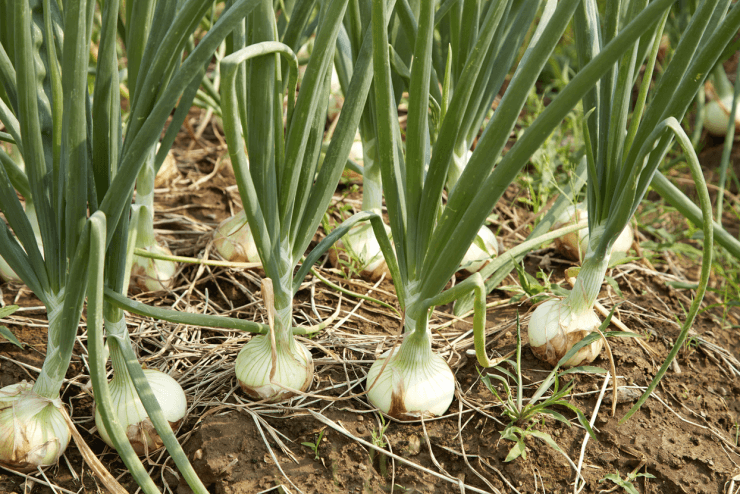
1. Choose planting location carefully
Avoid planting onions where you have previously planted crops such as beans, peas, tulips, potatoes, leeks, chicory, strawberries, cucumbers, beets, celery, spinach, lettuce, or other onions. They are susceptible to the same diseases and many bacteria, fungi, and viruses live in the soil for years, just waiting to prey on your onion plants!
Avoid planting the same crops nearby, as having them in the area could facilitate the rapid spread of any developing disease.
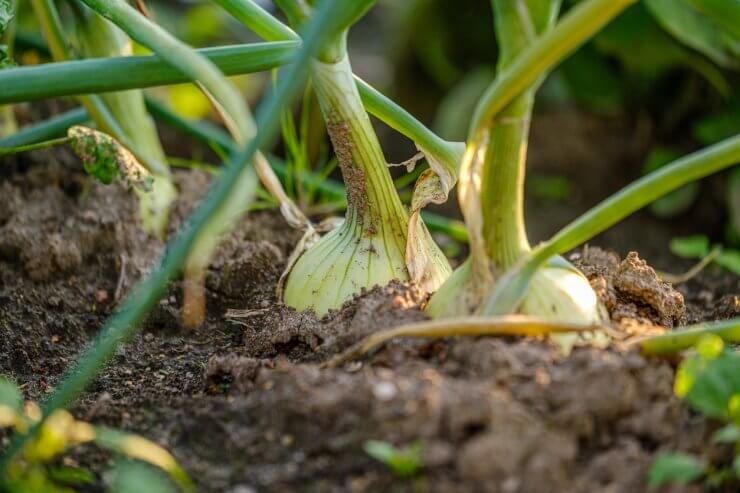
Now, some gardeners have had success planting onions near spinach, lettuce, and strawberries. But know that you run the risk of your onions falling prey to nematodes if you do choose these as companion plants. It’s a good idea to talk to your local garden center or other gardeners in your area to find out what their experience has been with these plants since there doesn’t seem to be one definitive answer to whether they’re compatible with onions.
And in the interest of good soil health practice, it’s a good idea to give an area a rest from onions for 3-4 years before you plant onions there again. If you have raised beds or containers, you could replace the soil if you’re really focused on onions for the next growing season.
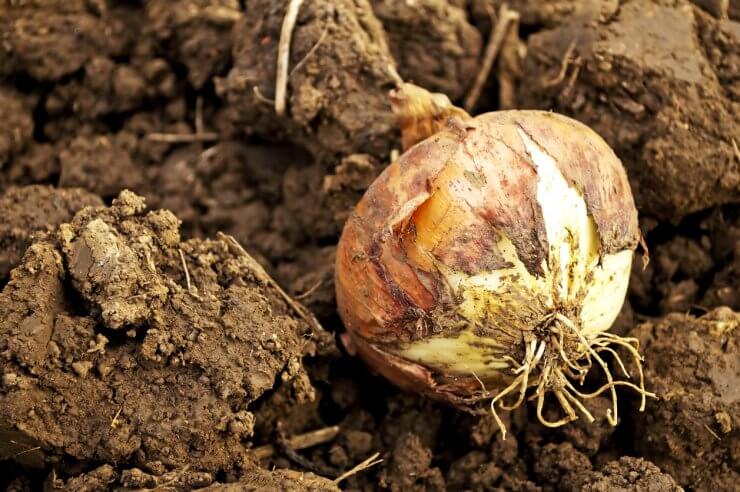
2. Improve your soil composition
Onions like well-drained soil with a pH between 6.0 and 7.0, and they like it full of tasty organic matter. Whether and how much you fertilize your onions depends on the composition of your soil. The first step to understanding the nutrient content of your soil is to get it tested.
If you can’t get your soil tested, then just use a balanced fertilizer, like 8-8-8 or 10-10-10. Onions need a good supply of nitrogen—but not too much. Too much nitrogen can make the plant take longer to mature. It can also cause soft bulbs, which will greatly decrease the onion’s storage life.
Side dress your onions after the root systems are well developed. Spread the fertilizer along your onion row, and gently work it in with a shallow rake or gardening fork. Whatever you do, don’t use any of those “weed & feed” fertilizers. They contain weed killers that can kill your onions and other vegetables in your garden.
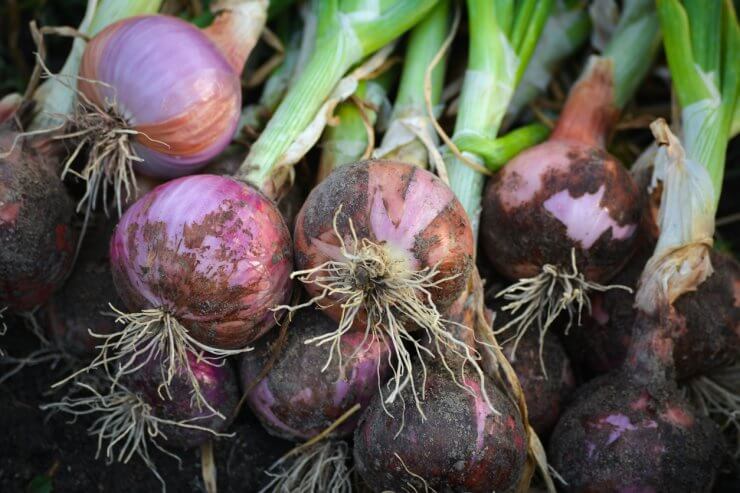
3. Plant disease-resistant onion varieties
Many onion varieties have been developed specifically to resist particular onion diseases. You can plant disease-resistant onion varieties to always have the healthiest plants and harvest. One common disease is Pink Root onion disease, which can ruin your onion crop. As its name suggests, the fungus responsible for this disease turns the onion roots pink, then purple. The only way to confirm the disease is to pull up the plants and check them. Among other things, one way to avoid disease in your onions and elsewhere is not to wear your gardening shoes to the garden center (you don’t want to track anything back into the garden with you).
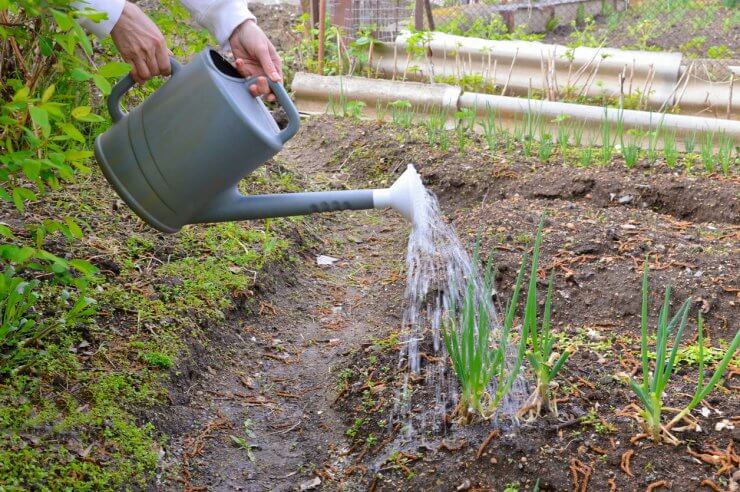
4. Water your garden properly
Onions need consistent watering, especially during the growing season—but you don’t want to soak them. Too much water is as bad, or worse than, too little. About an inch per week is a good idea. Water once or twice a week, unless it’s particularly dry in your area. Just keep an eye on your onion plants and don’t let them go thirsty. If you have sandy soil, you’ll have to water more often. You can check the soil by using a trowel to dig down a little next to your plants. If the soil is wet only an inch or two down, you need to water more. You can stop watering once your onion bulbs have reached their full size and the plants begin to topple over. But until then, keep watering!
Once the onion plants are tall enough, you can lay down some mulch around the plants, in a layer about 2 inches deep. This will do two things: 1. it will lock in moisture, and 2. it will cut off the light to any weeds that are working their way out of the soil. Straw is a good choice for mulch—straw, not hay. It will also make good compost at the end of the season. Other good mulch choices include grass clippings, shredded leaves, or cured, shredded wood mulch.
Tip: Early morning is the best time of day to water your onion plants. Avoid watering during the evening or night; that can encourage the growth of mold and mildew.
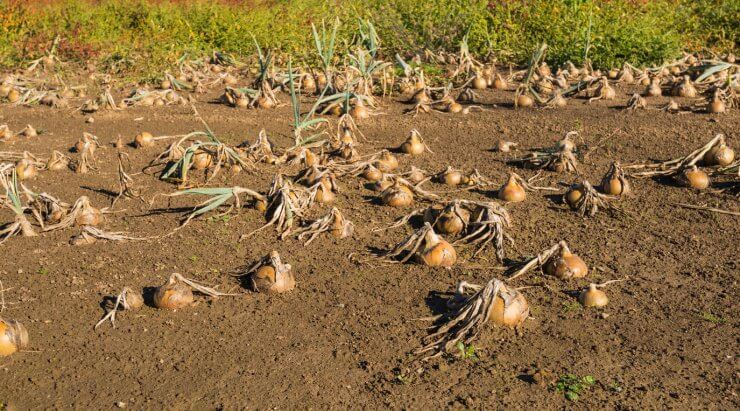
5. Destroy infected plants
Throw away or burn infected plants. Don’t keep infected plants over the winter in your garden, and don’t throw them on your compost pile. Disease-ridden plants, even when dead, will spread the disease to other plants or even your soil.
Start Growing Onions at Home Today
Onions make everything taste better! From burgers to salads to soups and more, onions offer a broad range of flavors from sweet to zesty. Gardeners love to grow them, and their friends and family love to eat them—raw or cooked! With The Outstanding Onion Gardening Guide, you’ll have everything you need to know about growing and enjoying this versatile food. From the history and background of the zesty onion to specific advice about soil requirements and fertilizer … from watering techniques to details about avoiding root rot … from easy-to-make and delicious recipes that will allow you to enjoy the fruits of your gardening labor to the nutritional benefits of onions—get it all in The Outstanding Onion Gardening Guide right now!
Have you had problems with diseases attacking your onion plants? What types of problems do you regularly face with your onion plants? Please tell us how you treat and prevent diseases from destroying your onion crop.


 Previous
Previous


I grew onions from onion sets in a raised bed about 4 ft above the ground. I watered and fertilized but still have very small onions. Advice please.
Onions don’t like to compete for water and nutrients so its best to give them space and apply a thick layer of mulch to keep them moist while avoiding weeds. As a rule, each onion leaf represents a layer of the onion, so the more leaves, the bigger the onion. Avoid high nitrogen fertilizer which can stunt the growth of the bulb.
I’ve never grown onions. I read the above, twice, about caring for them, but could not find how far down I plant them. Cover the onion entirely or only go half way up the onion?
You’ll want to barely cover the onion with soil.